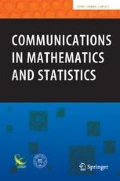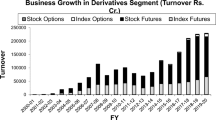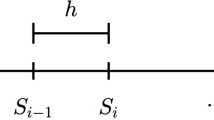Abstract
In this paper, we derive new closed-form valuations to European options under three-factor hybrid models that include stochastic interest rates and stochastic volatility and incorporate a nonzero covariance structure between factors. We make novel use of the empirically proven 3/2 stochastic volatility model with a time-dependent drift in which we are free to choose the moving reversion target. This model has been shown by many authors to empirically outperform other volatility models in maximising model fit. We also improve the valuation of European options under the Heston volatility and Cox, Ingersoll, Ross interest rate model, recently published in the literature, by replacing open-form infinite series with closed-form analytic expressions. For completeness, we also add a fuller covariance structure in this setting and detail closed-form valuations for options. The inclusion of nonzero covariances amongst the factors can significantly improve option pricing by allowing for a wider variety of market behaviour. The solutions are derived by firstly formulating the price of a European call option in terms of the corresponding characteristic function of the underlying price and then determining a partial differential equation for the characteristic function. By including empirically proven models into our analysis, the options formulae could provide more realistic prices for investors and practitioners.





Similar content being viewed by others
Notes
References
Abramowitz, M., Stegun, I.A.: Handbook of Mathematical Functions. Dover Publications, New York (1965)
Abudy, M., Izhakian, Y.: Pricing stock options with stochastic interest rate. Int. J. Portf. Anal. Manag. 1(3), 250–277 (2013). https://doi.org/10.1504/IJPAM.2013.054408
Alam, M.M., Uddin, G.: Relationship between interest rate and stock price: empirical evidence from developed and developing countries. Int. J. Bus. Manag. 4(3), 43–51 (2009). https://ssrn.com/abstract=2941281
Andreasen, J.: Closed-form pricing of FX options under stochastic rates and volatility. In: Global Derivatives Conference, ICBI (2006)
Antonov, A., Arneguy, M., Audet, N.: Markovian projection to a displaced volatility Heston model. In: 2008 Working Paper (2008). http://ssrn.com/abstract=1106223
Bakshi, G., Cao, C., Chen, Z.: Empirical performance of alternative option pricing models. J. Financ. 52(5), 2003–2049 (1997). https://doi.org/10.1111/j.1540-6261.1997.tb02749.x
Bakshi, G., Ju, N., Ou-Yang, H.: Estimation of continuous-time models with an application to equity volatility dynamics. J. Financ. Econ. 82(1), 227–249 (2006). https://doi.org/10.1016/j.jfineco.2005.09.005
Bailey, W., Stulz, R.M.: The pricing of stock index options in a general equilibrium model. J. Financ. Quant. Anal. 24(1), 1–12 (1989). http://www.jstor.org/stable/2330744
Black, F., Scholes, M.: The pricing of options and corporate liabilities. J. Polit. Econ. 81, 637–659 (1973). https://www.journals.uchicago.edu/doi/10.1086/260062
Brigo, D., Mercurio, F.: Interest Rate Models—Theory and Practice: With Smile, Inflation and Credit. Springer, Berlin (2007)
Carr, P., Geman, H., Madan, D.B., Yor, M.: Stochastic volatility for Lévy processes. Math. Financ. 13(3), 345–382 (2003). https://doi.org/10.1111/1467-9965.00020
Carr, P., Wu, L.: What type of process underlies options? A simple robust test. J. Financ. 58(6), 2581–2610 (2003). https://doi.org/10.1046/j.1540-6261.2003.00616.x
Chacko, G., Viceira, L.M.: Spectral GMM estimation of continuous-time processes. J. Econ. 116, 259–292 (2003). https://doi.org/10.1016/S0304-4076(03)00109-X
Christoffersen, P., Jacobs, K., Mimouni, K.: Volatility dynamics for the S&P500: evidence from realized volatility, daily returns and option prices. Rev. Financ. Stud. 23(8), 3141–3189 (2010). https://doi.org/10.1093/rfs/hhq032
Drimus, G.G.: Options on realized variance by transform methods: a non-affine stochastic volatility model. Quant. Financ. 12(11), 1679–1694 (2012). https://doi.org/10.1080/14697688.2011.565789
Ballester, L., Ferrer, R., Gonzlez, C.: Linear and nonlinear interest rate sensitivity of Spanish banks. Span. Rev. Financ. Econ. 9(2), 35–48 (2011). https://doi.org/10.1016/j.srfe.2011.09.002
Flannery, M., James, C.M.: The effect of interest rate changes on the common stock returns of financial institutions. J. Financ. 39(4), 1141–1153 (1984). https://EconPapers.repec.org/RePEc:bla:jfinan:v:39:y:1984:i:4:p:1141-53
Giese, A.: On the pricing of auto-callable equity securities in the presence of stochastic volatility and stochastic interest rates. Presentation (2006). https://www.scribd.com/document/273887110/Auto-Call-Able-s
Goard, J.: New solutions to the bond-pricing equation via Lie’s classical method. Math. Comput. Model. 32, 299–313 (2000). https://doi.org/10.1016/S0895-7177(00)00136-9
Grzelak, L.A., Oosterlee, C.W.: On the Heston model with stochastic interest rates. SIAM J. Financ. Math. 2(1), 255–286 (2011). https://papers.ssrn.com/sol3/papers.cfm?abstract_id=1382902
Grzelak, L.A., Oosterlee, C.W., Van Weeren, S.: Extension of stochastic volatility equity models with the Hull–White interest rate process. Quan. Financ. 12(1), 89–105 (2012). https://doi.org/10.2139/ssrn.1344959
Haowen, F.: European option pricing formula under stochastic interest rate. Prog. Appl. Math. 4(1), 14–21 (2012). https://doi.org/10.3968/j.pam.1925252820120401.Z0619
He, X.-J., Zhu, S.-P.: A closed-form pricing formula for European options under the Heston model with stochastic interest rate. J. Comput. Appl. Math. 1, 11 (2017). https://doi.org/10.1016/j.cam.2017.12.011
Heston, S.L.: A closed-form solution for options with stochastic volatility with applications to bond and currency options. Rev. Financ. Stud. 6, 327–343 (1993). https://doi.org/10.1093/rfs/6.2.327
Hull, J., White, A.: The pricing of options on assets with stochastic volatility. J. Financ. 42, 281–300 (1987). https://doi.org/10.1111/j.1540-6261.1987.tb02568.x
Hunter, C., Picot, G.: Hybrid derivatives: financial engines of the future. In: Nicholson, L. (ed.) The Euromoney Derivatives and Risk Management Handbook 2005/2006. Euromoney Books, London (2006)
Jones, C.: The dynamics of stochastic volatility: evidence from underlying and options markets. J. Econ. 116, 181–224 (2003). https://doi.org/10.1016/S0304-4076(03)00107-6
Kim, Y.-J.: Option pricing under stochastic interest rates: an empirical investigation. Asia Pac. Financ. Mark. 9(1), 23–44 (2002). https://doi.org/10.1023/A:1021155301176
Lewis, A.L.: Option Valuation Under Stochastic Volatility. Finance Press, Newport Beach (2000)
Maplesoft, Maple: 12 Users Manual. Maplesoft, Waterloo (2008)
Rindell, K.: Pricing of index options when interest rates are stochastic: an empirical test. J. Bank. Financ. 19(5), 785–802 (1995). https://doi.org/10.1016/0378-4266(94)00087-J
Schöbel, R., Zhu, J.: Stochastic volatility with an Ornstein–Uhlenbeck process: an extension. Rev. Financ. 3(1), 23–46 (1999). https://doi.org/10.1023/A:1009803506170
Scott, L.O.: Option pricing when the variance changes randomly: theory, estimation and an application. J. Financ. Quant. Anal. 22, 419–438 (1987). https://doi.org/10.2307/2330793
Stein, E.M., Stein, J.C.: Stock price distributions with stochastic volatility: an analytical approach. Rev. Financ. Stud. 4, 727–752 (1991). https://scholar.harvard.edu/stein/publications/stock-price-distributions-stochastic-volatility-analytic-approach
Van Haastrecht, A., Lord, R., Pelssser, A., Schrager, D.F.: Pricing long-maturity equity and FX derivatives with stochastic interest rates and stochastic volatility. Insur. Math. Econ. 45, 436–448 (2009). https://www.researchgate.net/publication/228163489_Pricing_Long-Maturity_Equity_and_FX_Derivatives_with_Stochastic_Interest_Rates_and_Stochastic_Volatility
Wiggins, J.: Option values under stochastic volatility: theory and empirical estimates. J. Financ. Econ. 19, 351–372 (1987). https://doi.org/10.1016/0304-405X(87)90009-2
Wilmott, P.: Derivatives: the theory and practice of financial engineering. Wiley, New York (1997)
Author information
Authors and Affiliations
Corresponding author
Appendices
Appendix A: Series Solution (4.4)
The coefficients of the first few terms of \(E= \sum _{n=0}^{\infty } \psi _n \tau ^n\) as in Eq. (4.4) with \(c= {d-(a_7\rho \sigma -k)\over \sigma ^2}, \ a_1 = -\alpha +a_7\gamma \eta , \ a_5 = \gamma \chi a_7,\ a_2 = a_7(1-{\gamma ^2\over 2}) -{\phi ^2\gamma ^2\over 2}, \ \beta _4 = \gamma \eta a_7, \ a_7 = j\phi \), found using the mathematics package Maple (see [30]) are listed below:
Appendix B: Series Representations
The series for the functions W, P, Q and R as given in (4.9)–(4.11) with \(c= {d-(a_7\rho \sigma -k)\over \sigma ^2}, \ a_1 = -\alpha +a_7\gamma \eta , \ a_5 = \gamma \chi a_7,\ a_2 = a_7(1-{\gamma ^2\over 2}) -{\phi ^2\gamma ^2\over 2}, \ \beta _4 = \gamma \eta a_7, \ a_7 = j\phi \), are given by
where
Appendix C: A Note on the 3/2 Stochastic Volatility Model with a Full Correlation Structure
With \(\delta =1, \ p={3\over 2} \) and letting \(k=a, \theta = A/a\), so that the volatility dynamics is
we need to solve (4.2) for the corresponding characteristic function. If we let
then on substituting into (4.2), we find that N needs to satisfy
where \(a_7 = j\phi \) and subject to \(\tau =0, N= 1.\) With \(\chi \ne 0\), (C.1) does not admit solutions of the form \(F(r,\tau )G(v,\tau )\) or any Lie symmetries apart from the usual superposition and scaling symmetries of linear PDEs.
Rights and permissions
About this article
Cite this article
Goard, J. Closed-Form Formulae for European Options Under Three-Factor Models. Commun. Math. Stat. 8, 379–408 (2020). https://doi.org/10.1007/s40304-018-00176-x
Received:
Revised:
Accepted:
Published:
Issue Date:
DOI: https://doi.org/10.1007/s40304-018-00176-x




